
How to read them
(in depth)

French or Modern or Astronomic or Equinoxial hours
Sun True Time, Sun Mean Time, Time Zone Time (TMEC)
Temporal or canonic hours
This is an ancient method of measurement of the time in the day. It is mentioned in the Scriptures (""About the third hour he went out.... He went out again about the sixth hour and the ninth hour.... About the eleventh hour he went out..." - Matthew 20, 1-16).
The day is divided, from dawn to sunset, into 12 equal hours that are called first, second etc.
Being the day length different in the year (longer in summer, shorter in winter, equal to 12 current hours at the equinoxes only) as a consequence the length of a canonic hour is not constant during the year. This was not a problem in the past but it would be unacceptable today.
They were used until about the XII century.
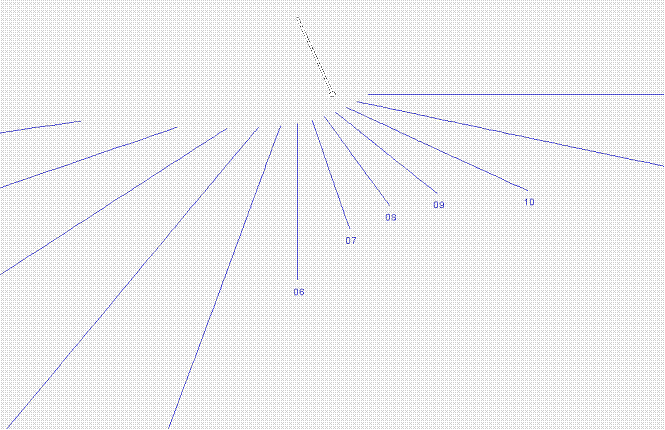
Fig. 2 — Temporal hours
Babilonic and Italic hours
They are equal hours, that is their length is constant through all the year. They are obtained by dividing the whole day into 24 equal sections of time and taking respectivley the sunrise or the sunset as the hour 0 (or 24).
As sunrise and sunset happen at different times in the year, even if these hours are of constant length, they do not have a fixed easy relationshiop with our current hours.
They were introduced in the 1200 under the influence of Arab culture and also because mechanical clocks were being used and of course these had to use cunits of time constant in the year.
Babilonic and especially Italic hours can still be found on ancient dials, often together with french hours, sometimes they are even drawn on modern dials.
Hour lines do not converge in one single point. Babilonic dials (fig. 3) show a horizontal line at the left of the dial (this is hour 0 at sunrise, it is not present in fig. 3 as this dial is declining to west and it is not lighted at sunrise) and the following hour lines are more and more inclined toward the vertical. Italic dials are the mirror of Babilonic dials : they show a horizontal line at the right of the dial (hour 24 at sunset) and previous lines are more and more inclined to the vertical (fig. 4).
It is worthy to note that from the observation of both types of hours it is possible to know how much time passed from sunrise (babilonic hour), how much time is left to sunset (24 - italic hour) and how long is the day (sum of the two previous numbers). It is evident that these information were extremely important in the ancient world.
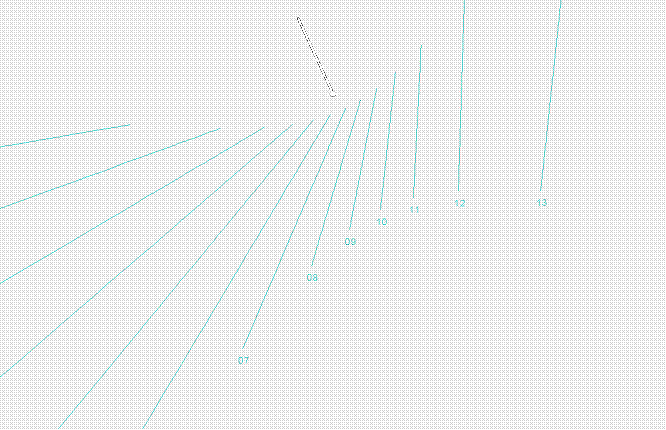
Fig.
3 —
Babilonic hours
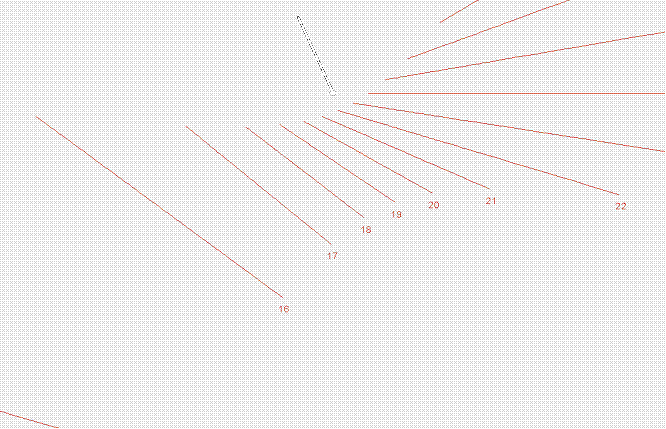
Fig. 4 —
Italic hours
French or Modern or Astronomic or Equinoxial hours
This time system was introduced between the end of 1700 and the beginning of 1800, it's the time system that is still in use nowadays.
These hours divide the whole day into 24 equal parts, hour 12 is at the sun transit on the local meridian (this is the instant of maximum sun elevation in the sky) and hour 0 (or 24) is at midnight.
A sundial with such a time system can be identified by the presence of
straigth hour lines that converge into a single point (that is also the
base of the polar style).
Fig. 5 shows a sundial that contains babilonic, italic and french hour lines together with date lines. Note that, being the dial declining to west, the babilonic hour 0 (sunrise) is not shown while the italic hour 24 (sunset) is.
It is worthy to note that on the equinoxial line all the three time systems overlap3, being the day duration at the equinox exactly 12 hours.
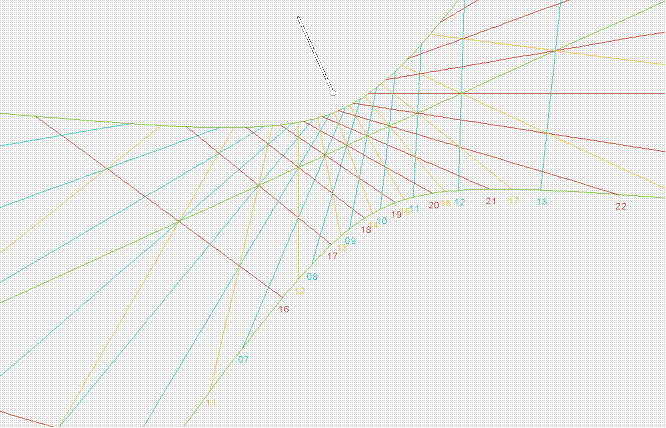
Fig. 5 — Babilonic, Italic and French hours
As a last remark, fig. 3, 4 and 5 show some hour lines, or segments of hour lines, that will never be touched by the style shadow, for instance italic lines 1, 2 and 3 that correspond to night hours. It could be judged as a mistake from a technical point of view but I think that the graph of fig. 5 is much more pleasant than a graph where lines are sharply cut off.
Fig. 6 is a graphic summary of the definition of temporal, babilonic and italic hours compared to current astronomic (or french) hours.
3 This overlap
would not subsist if french lines were calculated according to the
applicable time zone, t.i. including the longitude error : in this case
french hour lines would be translated of an angle related to the
longitude difference while italic and babilonic hour lines would not be
changed.
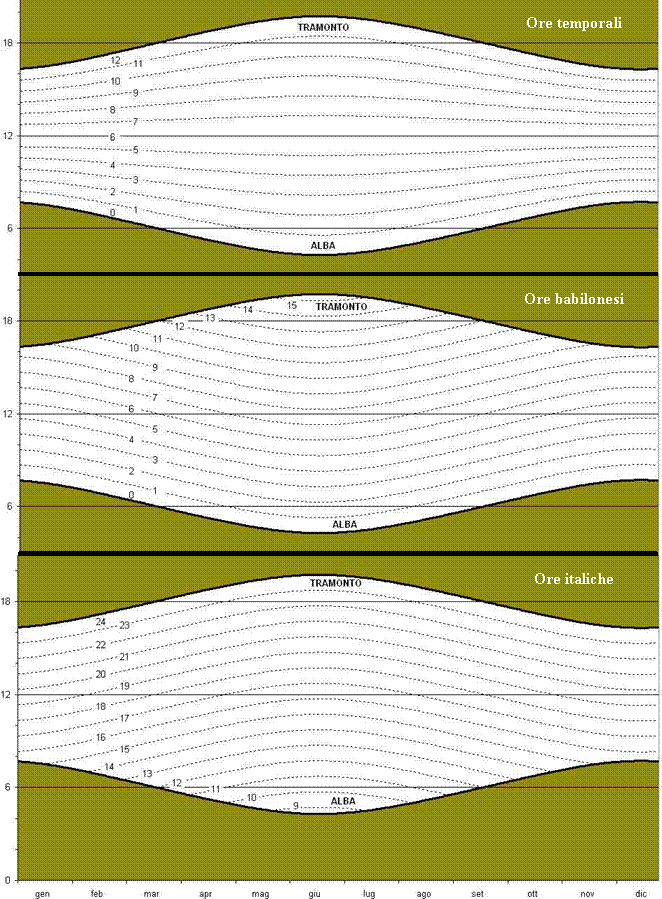
Fig. 6 — Comparison in the year
Sun True Time, Sun Mean Time, Time Zone Time
A sundial shows the current time by means of the angular position of the sun with respect to the earth.
This means that a sundial measures the Sun True Time : this is related to the place longitude and it changes from place to place, even within the same country (f.i. noon is the instant when the sun is on the local meridian, so it happens at diferrent times for two places with a different longitude).
The
Sun Mean Time is the Sun True Time averaged on the year in order to keep
the hour length constant during the year.
In fact we saw when speaking about the Equation of Time (EoT) that the
apparent movement of the sun in the sky is not constant in the year and
so days do not always have the same duration. When in the past
mechanical clocks started to be used, it was decided to create a virtual
mean time that keeps days constant in the year.
In the 19th century (in Italy in 1866) the time measurement based on the
place longitude, that is the Sun True Time or the Sun Mean Time, was
given up, and the country capital time first and the reference meridian
time (Time Zone Time) later were chosen.
In Europe this last time reference is called Central Europe Mean Time
(TMEC) and in Italy it was introduced in 1893.
The difference that exists between Sun Mean Time and Time Zone Time
A sundial can be designed in order to show one of two possible times:
-
Sun True Time : in this case the error with respect to our wristwatch is the longitude error added to the EoT;
noon line is always vertical -
Time Zone Time : the error with respect to our wristwatch is the only EoT. Noon line is moved from the vertical of an angle that is proportional to the distance to the reference meridian, it is moved to the left for places at the west and to the right for places at the east of the reference meridian.
In both these situations the dial can include the Analemma : in this case it will also show the Mean Time (local or related to the time zone).
Analemma
We have said that the true time (the one strictly related to the apparent movement of the sun) and the mean time (the virtual one that men invented for practical reasons) differ of a quantity that changes in the year and it is called Equation of Time (EoT).
A sundial necessarily shows the true time so one needs to correct the reading in order to obtain the mean time.
Actually it is possible to include this correction in the dial itself. Instead of drawing a straigth hour line according to the true time, we have to draw point by point the position of the shadow of the tip of the style at each hour during the year.
An 8 shaped curve, called Analemma (Lemniscata in latin countries), is so obtained that permits to read the mean time directly.
In order to keep the dial drawing as simple as possible, the analemma is
usually drawn on the noon line only4.
For all the year at 12 o'clock the shadow of the tip of the style tracks
the analemma curve. The path that the shadow covers in the year is (fig.
7) :
-
the upper left section (from winter solstice line to equinox line) in winter
-
the lower right section (from equinox line to summer solstice line) in spring
-
the lower left section (from summer solstice line to equinox line) in summer
-
the upper right section (from equinox line to winter solstice line) in fall
The picture in fig. 8 shows an example of sundial that shows the Central Europe Mean Time and that includes the an analemma at noon.
Fig. 9 shows the analemma as it is really drawn by the sun in the sky. It is made of several superimposed pictures, shot at the same time (local noon) in different days in the year.
It shows horizontally the displacement of the sun with respect of our
wristwatch (showing the mean time)
4 However
sundials exist that include an analemma for each hour. Sometimes they
are split into two dials, the first for winter and spring, the second
for summer and fall, each one with half analemma.
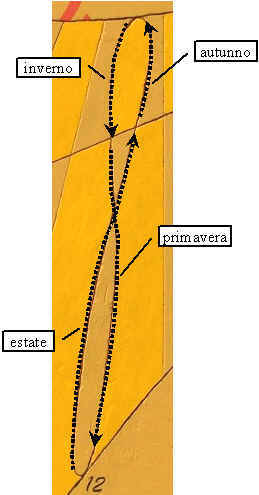
Fig. 7 — Analemma
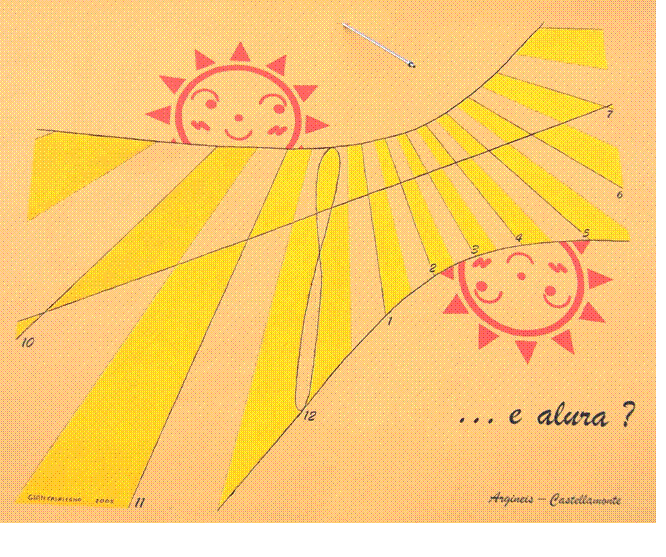
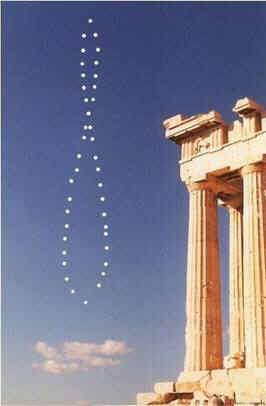
Fig. 8 — Sundial with analemma
Fig. 9 — Analemma (courtesy of Anthony
Ayiomamitis)
Polar style
In moder sundials the style is parallel to the earth axis.
Because of this position, when french hours are present, all the shadow of the style overlaps the hour lines, with no dependence on season. The result is a more pleasant and much easier reading.
Orthostyle
In ancient dials, and usually in all the dials with temporal, babilonic or italic hour lines, the style is orthogonal to the dial and it is called orthostyle.
When french hours are drawn, the only tip of the shadow marks the hour. Reading is so more difficult.
Meridian
In Italy the common name for the sundial is Meridiana that means Meridian.
However this is not correct as this name should be used for those dials that only show noon, usually the local noon. Often the noon line is marked with the zodiac signs and an analemma is included.
This type of dial was used in the past in order to synchronize mechanical clocks and bell towers.
This type of dial was also drawn in closed rooms, such as a church, with
a hole in the wall acting as the style tip. The purpose of these dials
was to perform astronomical measurements.
updated on venerdì 06 marzo 2015